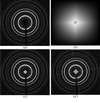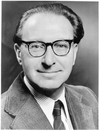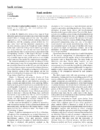issue contents
August 2008 issue

Cover illustration: Two-dimensional grazing-incidence X-ray scattering pattern for a PS-b-PI thin film deposited on a silicon substrate. Courtesy of Sangwoo Jin et al. [J. Appl. Cryst. (2007), 40, 950-958].
research papers
In situ small-angle X-ray scattering exhibits a non-monotonic evolution during the formation of resorcinol–formaldehyde gels. The data can be analyzed in terms of critical fluctuations, which points to a reaction-induced phase separation process.
The reciprocal space of the perfect icosahedral quasicrystal Al64Cu23Fe13 was explored employing synchrotron radiation and a novel type of single-photon-counting X-ray pixel detector, PILATUS 6M, which allows noise-free data collection with the extraordinarily large dynamic range of 20 bit.
Anomalous small-angle scattering of quasicrystals in a Zr–Pt binary alloy was examined at the Zr K absorption edge. Small differences in both density and composition were found between the quasicrystals and the amorphous matrix.
The relationship between long- and short-range order in nanocrystalline ZrO2–CaO solid solutions was investigated by synchrotron radiation X-ray powder diffraction and extended X-ray absorption fine structure spectroscopy.
A new electrochemical cell for in situ neutron diffraction measurements on materials for lithium-ion batteries is presented.
Experimental verification of dynamical diffraction focusing by a bent crystal wedge in Laue geometry
An experimental verification is presented of the fact that focusing by bent crystals in Laue geometry is strongly improved by combining geometrical focusing with Borrmann triangle focusing effects, as suggested from the X-ray dynamical diffraction theory.
A new procedure aimed at unfolding a two-dimensional powder diffraction image into both a one-dimensional azimuthal and a radial scan is presented.
Reverse Monte Carlo refinements using a combined real-space fit of the neutron/X-ray total scattering pair-distribution function and the extended X-ray absorption fine structure were developed and implemented as an extension to the public domain computer software RMCProfile. The effectiveness of the method was tested using perovskite Ca(Zr,Ti)O3 solid solutions.
The combination of two-dimensional scattering patterns measured with different instruments requires collimation correction. The method is demonstrated by small- and ultra-small-angle X-ray scattering of polymer fiber materials.
A small-angle light scattering instrument with a high resolution at low angles and a high signal-to-noise ratio has been developed. The characteristics of this instrument make it suitable for soft matter studies.
A new method has been developed for the application of absorption corrections to macromolecular crystallographic X-ray diffraction data. The approach uses a three-dimensional crystal model generated photographically so that path lengths through the crystal, the solvent and the crystal mount system can be determined reliably. Data from an insulin crystal at low incident beam energy have been recorded and processed using this approach.
Diffraction patterns obtained by X-ray and neutron diffraction are presented for several crystalline phases of the Y–Ni–B–C system.
The misorientation distributions about given rotation axes in deformed Cu single crystals are shown to be the same for X-ray diffraction (as standard rocking curves) and for high-resolution electron backscattered diffraction (as virtual rocking curves calculated from the orientation data). A new rotation axis imaging scheme is proposed for electron backscattered diffraction maps to highlight specific features of the deformation-induced sub-boundaries.
A focusing Laue diffractometer is presented for high-energy X-rays of up to 300 keV in a laboratory environment. The long attenuation length for high-energy X-rays allows for the non-destructive investigation of structural issues and bulk properties of single crystals.
A method is presented for creating an omit-map on the solvent of an X-ray crystal structure; this map can be used to refine and remove poorly resolved water molecules.
The positioning errors in an X-ray measurement with data acquisition during motor movements have been analyzed. The results show that during most scans in standard geometries data can be acquired even during uncoordinated motor movements between the measurement points without loss of accuracy.
The temperature-dependent post-perovskite structure model of MgSiO3 is reinvestigated through analysis of the total X-ray scattering from CaIrO3. In contrast to the results of a previous Rietveld structure refinement, showing a negative thermal expansion of Ir—O and Ca—O bond lengths, atom-pair distances in the pair-distribution function prove that these distances between atom pairs increase with temperature.
Open  access
access
 access
accessA new procedure for performing structural analysis of crystalline materials from diffraction data by random search and genetic algorithms is described.
cryocrystallography papers
The minimum glycerol concentrations required to obtain vitreous ice during plunge cooling of capillaries in liquid propane and nitrogen are determined as a function of capillary diameter and cooling rate. Capillary-based cryocrystallography will require much larger cryoprotectant concentrations than can be achieved with loop or microfabricated X-ray mount-based methods.
short communications
Open  access
access
 access
accessA point-focusing Johansson monochromator crystal prepared by hot-pressing a Ge single-crystal wafer is demonstrated. By using 333 diffraction, Cu Kα radiation was focused onto a small spot.
Electron backscatter diffraction and pole figures have been used to determine that the branches in α-cristobalite dendrite extend along [100] and [010] but not along 〈001〉. A new kind of twinning is found between two α-cristobalite dendrites: the twin axes are [110], [111] and [ 1], and the twin planes are (111) and (
1], and the twin planes are (111) and ( 1).
1).
The maximum disorientation angles between crystals of the 32 point groups were evaluated (together with their corresponding rotation axes) by constructing the fundamental zones of Rodrigues–Frank space. Only ten different maximum angles are possible for the 528 pairs of lattices.
CIF applications
Free 

A database-based approach to validation of CIFs to ensure compliance with data-range and enumeration specifications, to ensure compliance with parent–child relationships, and to detect missing and duplicated tags is presented.
computer programs
Open  access
access
 access
accessA description is provided of a software utility for creating interactive figures derived from crystal structures using the Java program Jmol.
QUALX is a new computer program for phase identification using powder diffraction data. Its main features are very effective automation, a user-friendly environment and free availability.
laboratory notes
A fast search method for Bragg reflexes of misoriented crystals in Berg–Barrett topography is presented.
A versatile and compact flow-cell/furnace that enables control of the sample atmosphere and temperature for in-situ X-ray scattering experiments is described.
crystallographers
Free 

book reviews
Free 



 journal menu
journal menu















































